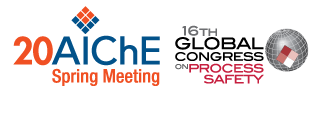

The quote “If you can’t measure it, you can’t manage it†is often used within the Process Industry to encourage companies to employ Process Safety Performance Indicators (PSPI) as an effective tool for monitoring and analysing the success of risk control measures both in terms of Leading (to provide advance warning of potential events) and Lagging (to record & evaluate these events when they occur). High Reliability Organisations (HRO) utilise these indicators to improve performance and increase engagement, however with so many indicators to choose from, it is likely that different sites, companies, countries and industries will have different sets of indicators and it is therefore more challenging to identify and analyse wider trends in similar applications to maximise shared knowledge. Furthermore, a good set of performance indicators may indicate that operations are 'safe' but are they safe enough?
This paper proposes a standard approach (called the Process Safety Index) which is based on established industry principles to objectively and consistently evaluate the fine balance between hazards and controls in order to assist duty holders to determine if they have sufficient protection in a way that can be anonymously compared across businesses without revealing sensitive process information. In simple terms, the Process Safety Index is an arithmetic evaluation of the overall Protection against the Threat(s) being addressed. It is an evolution of the familiar Dow Fire & Explosion index and considers not only flammable threats but also equipment hazards and the adequacy of prevention and mitigation measures (both technical and organisational).
Hazards are determined by two factors, the Properties of the chemicals e.g. from NFPA 704 and their Processing conditions & location. Each Properties/Chemical and Process/Conditions contribution is assigned an integer score (higher value indicates more severe potential for harm). Control is also determined by two factors, the Prevention measures (leading) and their actual Performance (lagging) e.g. from API 754 . Each Prevention/Leading and Performance/Lagging contribution is assigned an integer score (higher value indicates greater control). The Process Safety Index is the CONTROL score minus the HAZARD score which results in either a negative index, where the Hazard outweighs Control or a positive index, where Control outweighs the Hazard. The more negative or positive the index, the greater the imbalance in the respective direction. This index could be used as an event likelihood prediction tool similar to US Air Forces Defence Readiness Condition (DEFCON) alert state.
The Process Safety Index could be applied to a particular Unit Operation or Major Equipment which can then be aggregated up the asset hierarchy e.g. Unit | Area | Site | Region | Enterprise. For maximum visibility & engagement, colour coded Block Flow Diagrams (similar to OSHA PSM Appendix B) could be used. Ideally, the visualisation would be as ‘live’ as practical with interfaces to Process Control and Maintenance Management Systems. This could be used to predict future performance (expected to be Control degradation rather than short/medium term Hazard increase) in a similar way to stock/share prices. Companies could compare internal performance across sites, business units or regions and also external performance against industry peers (competitors) – albeit this would require hosting by a ‘neutral’ body e.g. a professional institution.
The principles of the Process Safety Index are similar to that of Risk where the Hazard represents the potential Consequences and the Control represents the Likelihood of these Consequences occurring, however by using internationally recognised components, the evaluation is less subjective, and the method of scoring Hazards can also be used for risk ranking within conventional Process Hazard Analyses such as HAZOP (severity) and Bowties (consequences). Future performance may be predictable (within reason) based on actual or anticipated degradation so that investment (or other) decisions can be made more confidently.
Presenter(s)
Once the content has been viewed and you have attested to it, you will be able to download and print a certificate for PDH credits.
If you have already viewed this content,
please click here
to login.
Language
Pricing
Individuals
| AIChE Member Credits | 0.5 |
| AIChE Pro Members | $19.00 |
| Employees of CCPS Member Companies | Free |
| AIChE Graduate Student Members | Free |
| AIChE Undergraduate Student Members | Free |
| AIChE Explorer Members | $29.00 |
| Non-Members | $29.00 |
